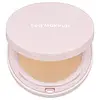What's inside
What's inside
 Key Ingredients
Key Ingredients

 Benefits
Benefits

 Concerns
Concerns

 Ingredients Side-by-side
Ingredients Side-by-side

Talc
AbrasiveTriethoxycaprylylsilane
Mica
Cosmetic ColorantPolyethylene
AbrasiveDimethicone
EmollientTridecyl Trimellitate
EmollientMagnesium Stearate
Cosmetic ColorantEthylhexyl Palmitate
EmollientSalicylic Acid
MaskingCeramide NP
Skin ConditioningNiacinamide
SmoothingC12-15 Alkyl Benzoate
AntimicrobialTocopheryl Acetate
AntioxidantUbiquinone
AntioxidantCarthamus Tinctorius Extract
EmollientHouttuynia Cordata Extract
Skin ConditioningCentella Asiatica Extract
CleansingCamellia Sinensis Leaf Extract
AntimicrobialPhenoxyethanol
Preservative1,2-Hexanediol
Skin ConditioningEthylhexylglycerin
Skin ConditioningCI 77891
Cosmetic ColorantCI 77492
Cosmetic ColorantCI 77491
Cosmetic ColorantCI 77499
Cosmetic ColorantTalc, Triethoxycaprylylsilane, Mica, Polyethylene, Dimethicone, Tridecyl Trimellitate, Magnesium Stearate, Ethylhexyl Palmitate, Salicylic Acid, Ceramide NP, Niacinamide, C12-15 Alkyl Benzoate, Tocopheryl Acetate, Ubiquinone, Carthamus Tinctorius Extract, Houttuynia Cordata Extract, Centella Asiatica Extract, Camellia Sinensis Leaf Extract, Phenoxyethanol, 1,2-Hexanediol, Ethylhexylglycerin, CI 77891, CI 77492, CI 77491, CI 77499
Talc
AbrasiveMica
Cosmetic ColorantCaprylic/Capric Triglyceride
MaskingMagnesium Stearate
Cosmetic ColorantNylon-12
Triethoxycaprylylsilane
Phenyl Trimethicone
Skin ConditioningKaolin
AbrasiveSilica
AbrasiveDiisostearyl Malate
EmollientPhenoxyethanol
PreservativeChamomilla Recutita Flower Extract
MaskingChrysanthellum Indicum Extract
Skin ConditioningTocopheryl Acetate
AntioxidantArtemisia Argyi Leaf Extract
Skin ConditioningEthylhexyl Methoxycinnamate
UV AbsorberHamamelis Virginiana Extract
AntiseborrhoeicRosa Rugosa Flower Extract
Skin ConditioningRosa Rugosa Flower Oil
MaskingOryza Sativa Powder
O-Cymen-5-Ol
AntimicrobialAcetyl Hexapeptide-8
HumectantSqualane
EmollientEthylhexylglycerin
Skin ConditioningMethicone
EmollientCI 77891
Cosmetic ColorantCI 77492
Cosmetic ColorantCI 77491
Cosmetic ColorantCI 77499
Cosmetic ColorantTalc, Mica, Caprylic/Capric Triglyceride, Magnesium Stearate, Nylon-12, Triethoxycaprylylsilane, Phenyl Trimethicone, Kaolin, Silica, Diisostearyl Malate, Phenoxyethanol, Chamomilla Recutita Flower Extract, Chrysanthellum Indicum Extract, Tocopheryl Acetate, Artemisia Argyi Leaf Extract, Ethylhexyl Methoxycinnamate, Hamamelis Virginiana Extract, Rosa Rugosa Flower Extract, Rosa Rugosa Flower Oil, Oryza Sativa Powder, O-Cymen-5-Ol, Acetyl Hexapeptide-8, Squalane, Ethylhexylglycerin, Methicone, CI 77891, CI 77492, CI 77491, CI 77499
Ingredients Explained
These ingredients are found in both products.
Ingredients higher up in an ingredient list are typically present in a larger amount.
Ci 77491 is also hydrated iron III oxide. It's sole purpose is to give a red/pink hue to products.
Iron III oxides are classified as inorganic chemicals for coloring.
Synthetically created Ci 77491 is considered safer than those naturally found. This is because the synthetically created version may contain less impurities. Iron oxides are generally non-toxic and non-allergenic.
Learn more about CI 77491Ci 77492 is also hydrated iron III oxide. It's sole purpose is to give a yellow hue to products.
Iron III oxides are classified as inorganic chemicals for coloring.
Synthetically created Ci 77492 is considered safer than those naturally found. This is because the synthetically created version may contain less impurities. Iron oxides are generally non-toxic and non-allergenic.
Learn more about CI 77492Ci 77499 is also hydrated iron III oxide. It is created from mixing red and black iron oxides. This helps give shades of darkness to a product.
Iron III oxides are classified as inorganic chemicals for coloring.
Ci 77891 is a white pigment from Titanium dioxide. It is naturally found in minerals such as rutile and ilmenite.
It's main function is to add a white color to cosmetics. It can also be mixed with other colors to create different shades.
Ci 77891 is commonly found in sunscreens due to its ability to block UV rays.
Learn more about CI 77891Ethylhexylglycerin (we can't pronounce this either) is commonly used as a preservative and skin softener. It is derived from glyceryl.
You might see Ethylhexylglycerin often paired with other preservatives such as phenoxyethanol. Ethylhexylglycerin has been found to increase the effectiveness of these other preservatives.
Magnesium Stearate is a salt that is 2 parts stearic acid and 1 part magnesium.
It is a white powder that can be used to add bulk and color to products by binding to oil ingredients.
Mica is a naturally occurring mineral used to add shimmer and color in cosmetics. It can also help improve the texture of a product or give it an opaque, white/silver color.
Serecite is the name for very fine but ragged grains of mica.
This ingredient is often coated with metal oxides like titanium dioxide. Trace amounts of heavy metals may be found in mica, but these metals are not harmful in our personal products.
Mica has been used since prehistoric times throughout the world. Ancient Egyptian, Indian, Greek, Roman, Aztec, and Chinese civilizations have used mica.
Learn more about MicaPhenoxyethanol is a preservative that has germicide, antimicrobial, and aromatic properties. Studies show that phenoxyethanol can prevent microbial growth. By itself, it has a scent that is similar to that of a rose.
It's often used in formulations along with Caprylyl Glycol to preserve the shelf life of products.
Talc is a clay mineral. It helps absorb moisture and improve the texture of products. Like other types of clay, Talc can have a slight exfoliating effect on skin. Talc can be added to increase the volume of products.
Some Baby powders are made by combining talc with corn starch. The word "talc" comes from Latin and originates from Arabic. Talc is a mineral commonly found throughout the world.
If you have any concerns about using talc, we recommend checking out the FDA's official page.
Learn more about TalcTocopheryl Acetate is AKA Vitamin E. It is an antioxidant and protects your skin from free radicals. Free radicals damage the skin by breaking down collagen.
One study found using Tocopheryl Acetate with Vitamin C decreased the number of sunburned cells.
Tocopheryl Acetate is commonly found in both skincare and dietary supplements.
Learn more about Tocopheryl AcetateTriethoxycaprylylsilane is a silicone used to bind and stabilize ingredients.
As an emulsifier, it helps prevent ingredients from separating. This can help elongate the shelf life of products.
Triethoxycaprylylsilane is often used to coat mineral sunscreens ingredients to help give a better feel. It also helps reduce oxidative stress in sunscreens.
Learn more about Triethoxycaprylylsilane